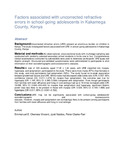Please use this identifier to cite or link to this item:
http://ir-library.mmust.ac.ke:8080/xmlui/handle/123456789/2066Full metadata record
| DC Field | Value | Language |
|---|---|---|
| dc.contributor.author | Vincent, Emmanuel E. Okenwa | - |
| dc.contributor.author | Naidoo, Jyoti | - |
| dc.contributor.author | Farr, Peter Clarke | - |
| dc.date.accessioned | 2022-09-19T11:30:49Z | - |
| dc.date.available | 2022-09-19T11:30:49Z | - |
| dc.date.issued | 2022-08-05 | - |
| dc.identifier.uri | https://doi.org/10.5603/OJ.2022.0021 | - |
| dc.identifier.uri | https://journals.viamedica.pl/ophthalmology_journal/article/view/OJ.2022.0021 | - |
| dc.identifier.uri | http://ir-library.mmust.ac.ke:8080/xmlui/handle/123456789/2066 | - |
| dc.description.abstract | Background: Uncorrected refractive errors (URE) present an enormous burden on children in Kenya. The study investigated factors associated with URE in school-going adolescents in Kakamega County, Kenya. Material and methods: An observational, cross-sectional study with multistage sampling was conducted with randomly selected secondary school students in forms one to four. Comprehensive clinical examinations conducted by optometrists were used to determine participants’ URE types and dioptric strength. Structured pre-validated questionnaires were administered to participants to elicit information on their sociodemographic and socioeconomic statuses. Results: A total of 165 students, aged 17.45 ± 1.44 years, with URE classified into myopia, hyperopia, and astigmatism, participated in the study. There were more males (57%) than females in this study, and most participants had astigmatism (52%). The study found no-to-weak association between predefined factors and URE. While males had decreased odds [odds ratio (OR): 0.557, 95% confidence interval (CI): 0.211–1.470] for myopia than astigmatism, the converse was true for hyperopia (OR: 1.165, 95% CI: 0.385–3.524) compared with astigmatism. Even though participants from families with lower affluence and living in rural settings had up to 18 times increased odds (OR: 18.699, 95% CI: 0.840–416.442) for myopia than astigmatism and hyperopia, significant dioptric power was less likely to be present in those with myopia (OR: 0.529, 95% CI: 0.165–1.698) and hyperopia (OR: 0.011, 95% CI: 0.001–0.192). Conclusions: URE may not be significantly associated with school-going adolescents’ sociodemographic and socioeconomic statuses. However, myopia and astigmatism are increasingly likely to be present among participants from families with lower affluence and living in rural settings. | en_US |
| dc.language.iso | en_US | en_US |
| dc.publisher | Ophthalmology Journal | en_US |
| dc.subject | Factors associated, uncorrected, refractive errors, school-going, adolescents, County, | en_US |
| dc.title | Factors associated with uncorrected refractive errors in school-going adolescents in Kakamega County, Kenya | en_US |
| dc.type | Article | en_US |
| Appears in Collections: | Gold Collection | |
Files in This Item:
| File | Description | Size | Format | |
|---|---|---|---|---|
| Factors associated with uncorrected refractive errors in school.pdf | 81.32 kB | Adobe PDF |  View/Open |
Items in DSpace are protected by copyright, with all rights reserved, unless otherwise indicated.
